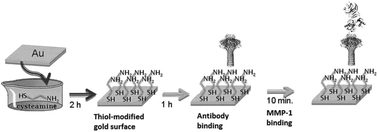The development of a matrix metalloproteinase-1 biosensor based on the surface plasmon resonance imaging technique
Abstract
The purpose of this study was to create a new, highly selective biosensor, which uses surface plasmon resonance as a detection method for the quantitative determination of the matrix metalloproteinase-1. The main part of the biosensor is an immobilized rabbit anti-human matrix metalloproteinase-1 antibody, which binds the enzyme from the sample. The analytical response signal of the biosensor is in the range of 0.05–20.00 ng ml−1. The detection limit is 9 pg ml−1, and the limit of quantification is 18 pg ml−1. The biosensor was used to measure the matrix metalloproteinase-1 concentration in the blood plasma of healthy persons and patients with bladder cancer with good results (good tolerance of the potential interferents). To validate the new analytical method, measurements of serum matrix metalloproteinase-1 concentration in the biological samples by Enzyme-Linked Immunosorbent Assay (ELISA) were conducted. Good correlation between these two methods was found. The developed biosensor can be successfully used for the quantitative determination of matrix metalloproteinase-1 in laboratories.


 Please wait while we load your content...
Please wait while we load your content...